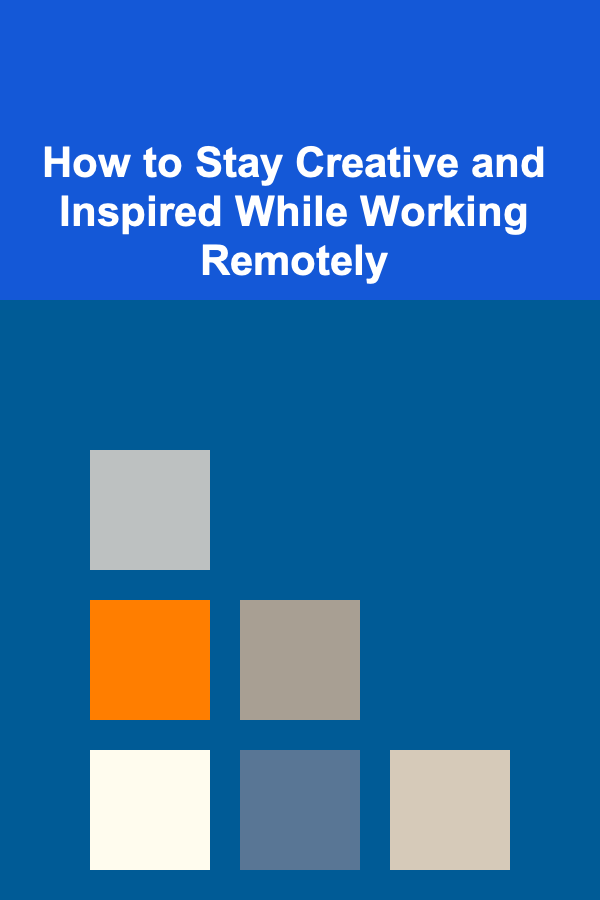
How to Stay Creative and Inspired While Working Remotely
ebook include PDF & Audio bundle (Micro Guide)
$12.99$11.99
Limited Time Offer! Order within the next:

In the past decade, remote work has transitioned from being a niche arrangement to a mainstream practice, with millions of professionals now working from home or other non-traditional environments. While this shift offers flexibility and freedom, it also comes with its own set of challenges---particularly when it comes to staying creative and inspired.
Remote work, for all its benefits, can sometimes feel isolating. Without the physical presence of colleagues and the typical office environment, it's easy for your creative juices to run dry. However, with the right strategies, remote workers can cultivate an inspiring and stimulating work atmosphere that encourages creativity. In this article, we will explore various techniques to help you stay motivated, energized, and creative while working remotely.
Set the Right Environment
The physical environment in which you work plays a significant role in how you feel and how productive you are. When working from home, it can be difficult to maintain a sense of separation between personal and professional life. However, a well-structured environment can help you stay focused and maintain creativity.
1.1. Create a Dedicated Workspace
Having a designated workspace within your home helps create a boundary between work and leisure, which is crucial for fostering creativity. This doesn't have to be a large home office; it could be a quiet corner, a nook, or even a section of your dining table. The key is to keep this area dedicated solely to work activities. This helps your brain associate the space with focus and productivity, making it easier to get into a creative flow.
1.2. Personalize Your Space
A creative workspace is one that feels both functional and inspiring. Personalizing your workspace can help make it a place that you look forward to spending time in. Here are some ideas for making your workspace more inspiring:
- Add art or photos that inspire you.
- Include plants or flowers to bring life to the space.
- Use lighting that is soft and warm to create a relaxed atmosphere.
- Keep your desk organized, but don't be afraid to have a few fun items that spark joy.
A space that resonates with you emotionally can improve your mood and spark new ideas.
1.3. Control Distractions
Working remotely means there are a variety of distractions, from household chores to family members or pets. To maintain creativity, it's important to minimize distractions:
- Set clear boundaries with others in your household about work hours.
- Use noise-canceling headphones to block out background noise.
- Turn off notifications on your devices to avoid constant interruptions.
Creating a distraction-free workspace can help you stay focused, which in turn allows for more creative thinking.
Establish a Routine
Although remote work provides flexibility, having a routine is key to maintaining focus and creativity. Establishing a structured day helps your mind stay sharp and productive.
2.1. Follow a Consistent Work Schedule
Without the structure of a traditional office, it's tempting to sleep in or take breaks whenever you want. However, keeping consistent hours for starting and ending your workday can help you stay organized and creative. Establishing a morning routine, whether it's a cup of coffee, a short walk, or a stretch, signals to your brain that it's time to get to work.
2.2. Break Tasks Into Manageable Chunks
Creativity can sometimes be stifled by large, overwhelming projects. Instead of attempting to tackle a big task all at once, break it down into smaller, more manageable chunks. This makes the work feel less daunting and encourages incremental creative progress. Tackling a task step by step also gives you more opportunities for creative breakthroughs as you approach the project from different angles.
2.3. Time Blocking and Pomodoro Technique
Time blocking is a time management technique where you allocate specific blocks of time for different tasks. This helps avoid distractions and ensures you're dedicating focused time to important tasks. Similarly, the Pomodoro Technique---a method where you work for 25 minutes and take a 5-minute break---has been shown to improve concentration and creativity by creating regular intervals of rest and focus.
By structuring your time, you're more likely to maintain your creative energy throughout the day.
Stay Connected with Colleagues
Although remote work isolates you physically from your coworkers, it's still important to foster social and professional connections. Collaboration and communication with others can serve as a source of inspiration and support.
3.1. Virtual Collaboration
One of the benefits of working remotely is the ability to collaborate virtually with teams across different time zones and locations. Tools like Slack, Zoom, and Microsoft Teams make it easy to communicate with colleagues, share ideas, and work on projects together. By using these tools effectively, you can stay in the loop and benefit from diverse perspectives, which can enhance your own creativity.
3.2. Schedule Regular Check-ins
While remote work offers independence, isolation can stifle creativity. Schedule regular check-ins with your team, whether it's a weekly meeting or a daily morning huddle. These sessions give you an opportunity to exchange ideas, share progress, and collaborate on problem-solving. It also prevents you from feeling disconnected, which can be a barrier to maintaining creative flow.
3.3. Join Virtual Communities
Beyond your immediate work group, consider joining online communities or forums that align with your industry or creative interests. Engaging in discussions with like-minded individuals can be a powerful way to stay inspired. Whether it's a writing group, design forum, or tech community, these groups can provide valuable insights and fresh ideas that invigorate your work.
Take Breaks and Practice Self-Care
Creativity doesn't flow endlessly, and if you try to push through without taking breaks, you'll likely burn out. Regular breaks and self-care practices are essential for staying creative and inspired.
4.1. Incorporate Movement
Sitting at a desk for long periods can dampen creativity. Incorporating physical activity into your day, even for just 10 to 15 minutes, can boost your energy levels and stimulate creative thinking. You don't have to do a full workout---simple stretches, a walk around the block, or a few minutes of yoga can help get your blood flowing and clear your mind.
4.2. Rest and Recharge
Getting enough rest is crucial for maintaining creativity. Lack of sleep can impair cognitive function, making it harder to think creatively. Prioritize good sleep hygiene, such as maintaining a consistent bedtime routine, avoiding screens before bed, and creating a calm environment for sleeping.
Taking time off during weekends or planning short vacations is also vital for long-term creativity. Periodic breaks give you a fresh perspective, which allows for better problem-solving and new ideas.
4.3. Practice Mindfulness
Mindfulness practices like meditation, breathing exercises, or journaling can be incredibly effective for resetting your mind. These activities encourage a state of calm and focus, which can help you clear mental clutter and re-center yourself. By incorporating mindfulness techniques, you create mental space for creativity to flourish.
Seek Inspiration Outside of Work
Sometimes, inspiration can come from the most unexpected places. Engaging in creative activities outside of work can recharge your batteries and give you fresh perspectives when you return to your tasks.
5.1. Explore New Hobbies or Interests
When you're working remotely, it's easy to become consumed by your job, especially when your workspace is at home. However, taking time to explore new hobbies or interests can stimulate your creativity. Whether it's painting, reading, photography, or learning a musical instrument, creative outlets outside of work can give your brain a break and help spark new ideas.
5.2. Immerse Yourself in Nature
Taking a walk in nature can do wonders for your creativity. Nature offers a calming environment that encourages reflection and mental clarity. Stepping away from your workspace and immersing yourself in the outdoors provides a change of scenery and a chance to gain new inspiration. It could be as simple as a stroll in the park or a weekend hike.
5.3. Consume Diverse Content
Expose yourself to a variety of content, whether it's books, podcasts, documentaries, or art. Exploring new ideas and perspectives will open your mind and give you new tools to approach your work in innovative ways. Inspiration often comes from the most unlikely sources, and by constantly feeding your mind with new stimuli, you ensure that your creativity is continually nurtured.
Embrace Flexibility
One of the advantages of remote work is the freedom and flexibility it provides. Embracing this flexibility can help you stay creative by allowing you to experiment with different workstyles, routines, and methods.
6.1. Try Different Work Hours
While sticking to a routine is important, remote work allows for flexibility in how you structure your day. Experiment with working at different times of the day to find when you are most creative. Some people work better in the mornings, while others are more productive in the late hours. Discovering your peak creativity times can help you tackle the most challenging tasks when your mind is freshest.
6.2. Mix Up Your Workspace
If you find yourself getting bored with your home office, try changing up your environment. Work from a café, library, or even a coworking space for a change of pace. A new setting can provide a fresh perspective and inspire creativity.
6.3. Stay Open to New Tools and Techniques
Remote work often requires the use of various digital tools for communication, collaboration, and task management. Stay open to experimenting with new tools and technologies that might streamline your workflow or enhance creativity. Tools like Trello, Miro, or even design software can help you approach tasks in different ways and boost creative thinking.
Keep Learning and Evolving
Creativity thrives when you're constantly learning and expanding your skill set. Remote work offers the opportunity to engage in continuous learning and self-improvement.
7.1. Take Online Courses
There are countless online courses available on a wide variety of topics, from technical skills to creative pursuits. Taking courses can not only enhance your skill set but also inspire new ideas. Learning something new, whether it's a coding language or a photography technique, can reignite your creative spark.
7.2. Attend Virtual Events
Attending virtual events like webinars, conferences, and workshops can expose you to new ideas, trends, and technologies. These events are also great for networking and engaging with others in your field. The insights gained from these events can be used to fuel your own creativity and work.
Conclusion
Staying creative and inspired while working remotely requires a combination of self-discipline, routine, and flexibility. By creating the right environment, maintaining a structured day, staying connected with colleagues, and taking care of your mental and physical health, you can foster an atmosphere that supports creativity. Additionally, seeking inspiration from outside your work environment and embracing continuous learning can help you stay motivated and innovative.
Ultimately, remote work doesn't have to stifle your creativity. By adopting strategies that promote balance, focus, and inspiration, you can ensure that your creative energy remains strong and that you continue to thrive in your remote work environment.

How to Find Local Resources for Financial Assistance
Read More
How to Provide Exceptional Customer Service in Your Beauty Salon Business
Read More
How to Store Cooking Oils Safely and Neatly
Read More
Turning Hobbies into Careers: Exploring Passion Projects
Read More
Understanding the Future of Organ Transplants
Read More
How to Create a Compelling Architectural Portfolio
Read MoreOther Products

How to Find Local Resources for Financial Assistance
Read More
How to Provide Exceptional Customer Service in Your Beauty Salon Business
Read More
How to Store Cooking Oils Safely and Neatly
Read More
Turning Hobbies into Careers: Exploring Passion Projects
Read More
Understanding the Future of Organ Transplants
Read More